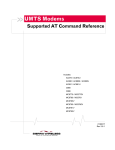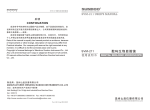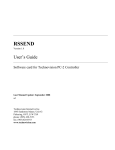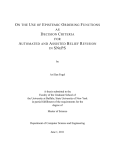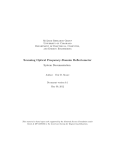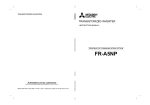Download Knowledge and Social Laws - Department of Computer Science
Transcript
Knowledge and Social Laws
Wiebe van der Hoek Mark Roberts Michael Wooldridge
Department of Computer Science
University of Liverpool
Liverpool L69 7ZF, UK
{wiebe,mark,mjw}@csc.liv.ac.uk
ABSTRACT
1. INTRODUCTION
In this paper we combine existing work in the area of social laws with a framework for reasoning about knowledge in
multi-agent systems. The unifying framework in which this
is done is based on Alternating-time Temporal Logic (ATL),
to which semantics we add epistemic accessibility relations
(to deal with the knowledge), actions (in order to naturally
talk about allowed and forbidden actions) and updates (to
model the effect of the implementation of the constraint in
a social law). Apart from a constraint, a social law has an
objective: in our formalism, such objectives may refer to
the knowledge that agents possess or do not possess. The
result is a framework in which we can, for example, express
that a desirable property (objective) of a social law is that
one agent has the ability to bring about a certain type of
knowledge in another agent, or that if one agent knows something, then it should behave in a certain way. We illustrate
our approach with a case study, and we use model checking
to demonstrate that properties of social laws with respect
to this case study.
A social law is a restriction on the behaviour of agents, to
ensure they can work individually in a mutually compatible
manner in order to fulfil their individual goals, and possibly
joint goals. Social laws work by prohibiting the performance
of certain actions in certain situations (states). The social
laws paradigm was first proposed by Moses, Shoham and
Tennenholtz [11, 10, 12, 8, 13, 14].
In [16], van der Hoek et al extend the social laws framework further. They show that Alternating-time Temporal
Logic (atl) provides a rich and natural technical framework
within which to investigate social laws and their properties.
In this framework, a social law consists of two parts: an
objective of the law, written as an atl specification, and a
behavioural constraint, which is a function that for every action returns the set of states where that action is forbidden
from being performed. The objective of the law represents
what the society aims to achieve by adopting the law, and
the behavioural constraint corresponds to the requirements
that the law places on the members of society.
With social laws expressed in this way, the problem of
determining whether a social law is effective corresponds to
an atl model checking problem. This is advantageous as it
allows the use of existing atl model checkers. Expressing
social laws in atl in this way clearly has other advantages
to it. Social laws frequently refer to the powers or rights (or,
conversely, the limits to powers) that agents have, so atl,
with its cooperation modalities, is a very natural choice to
express such laws. Also, atl has the ability to express laws
that refer to conditions that must hold over time. Finally,
[16] studies various computational problems in their new
framework of social laws, and found the complexity of the
feasibility problem for social laws in the most general case
to be no more complex than the corresponding problem in
the Shoham-Tennenholtz framework (it is np-complete).
However, the framework of [16] is based on quite a strong
and unrealistic assumption that agents know everything about the state of the system. This is modelled with a global
state space which all agents have access to. In this paper
we do away with the need for this assumption by extending
the framework further by incorporating the notion of knowledge. Knowledge is important in any non-trivial multi-agent
system, and as knowledge will come to play in almost any
coordination scenario, we can clearly see a need to extend
our framework. Not only will the agents’ knowledge of the
system be used in order to follow certain laws, but we can
have laws in which certain information must become known
(or remain private) to an agent or a coalition of agents.
Categories and Subject Descriptors
I.2.4 [Artificial Intelligence]: Knowledge Representation
Formalisms and Methods—Representation languages, Modal
logic, Temporal logic; I.2.11 [Artificial Intelligence]: Distributed Artificial Intelligence—Coherence and coordination,
Multiagent systems
General Terms
Theory, Design, Verification
Keywords
Social Laws, Alternating-time Temporal Epistemic Logic,
Knowledge
Permission to make digital or hard copies of all or part of this work for
personal or classroom use is granted without fee provided that copies are
not made or distributed for profit or commercial advantage and that copies
bear this notice and the full citation on the first page. To copy otherwise, to
republish, to post on servers or to redistribute to lists, requires prior specific
permission and/or a fee.
AAMAS’05, July 25-29, 2005, Utrecht, Netherlands.
Copyright 2005 ACM 1-59593-094-9/05/0007 ...$5.00.
So, by imposing certain social laws, we can force desirable
knowledge properties to hold.
Furthermore, we can have laws which are only known to
a certain agent or group of agents, and only these agents
need follow the law. In this paper, we demonstrate how to
‘transform’ the objective of a social law in several, individual
objectives, which have a feasible format: depending on the
information the agent has, he is required to achieve some
situation that is under his control.
This paper is structured as follows: We begin by introducing Action-based Alternating Epistemic Transition Systems (aaetss), based on an essentially equivalent version
of the structures of [16] but extended in order to represent
the knowledge of the agents; we then introduce Alternating
Temporal Epistemic Logic (atel) itself, the logic we will
use to express social laws. In section 4 we formally define
this new extended framework of social laws with respect to
aaets and atel; and then in section 5 we present a case
study to illustrate the power of our framework and to show
how model checking can be performed using standard atl
model checkers. A discussion of related work is presented in
section 6, while section 7 concludes.
2.
SEMANTIC STRUCTURES
In [16] the semantic structures used are known as Actionbased Alternating Transition Systems (aatss) and are essentially equivalent to the alternating transition systems used
by Alur and colleagues to give semantics to atl (see [2]). In
this section we extend aatss into what we call Action-based
Alternating Epistemic Transition Systems (aaetss). The
main difference is that we introduce an epistemic accessibility relation for each agent in the system, which is used to
capture each agent’s knowledge. The approach is standard
in the literature of epistemic logic [5, 7].
We first assume that the systems of interest to us may be
in any of a finite set Q of possible states, with some q0 ∈ Q
designated as the initial state. Systems are populated by a
set Ag of agents; a coalition of agents is simply a set G ⊆ Ag,
and the set of all agents is known as the grand coalition.
Each agent i ∈ Ag is associated with a set Aci of possible
actions, and we assume that these sets of actions are pairwise disjoint. We denote the set of actions
S associated with
a coalition G ⊆ Ag by AcG , so AcG = i∈G Aci . A joint
action for a coalition G is an indexed tuple hα1 , . . . , αk i,
where αi ∈ Aci , for each i ∈ G. We denote Q
the set of
all joint actions for coalition G by JG , so JG = i∈G Aci .
Given an element j of JG and agent i ∈ G, we denote i’s
component of j by ji . Now, for each agent i ∈ Ag, we
also have an epistemic accessibility relation ∼i , which represents indistinguishable states to agent i, used to capture
i’s knowledge. Thus, an aaets is an (2n + 7)-tuple
hQ, q0 , Ag, Ac1 , . . . , Acn , ∼1 , . . . , ∼n , ρ, τ, Φ, πi
where:
• Q is a finite, non-empty set of states;
• q0 ∈ Q is the initial state;
• Ag = {1, . . . , n} is a finite, non-empty set of agents;
• Aci is a finite, non-empty set of actions, for each i ∈
Ag, where Aci ∩ Acj = ∅ for all i 6= j ∈ Ag;
• ∼i ⊆ Q × Q is an epistemic accessibility relation for
each agent i ∈ Ag. Each ∼i must be an equivalence
relation;
• ρ : AcAg → 2Q is an action precondition function,
which for each action α ∈ AcAg defines the set of states
ρ(α) from which α may be executed;
• τ : Q × JAg → Q is a partial system transition function, which defines the state τ (q, j ) that would result
by the performance of j from state q;
• Φ is a finite, non-empty set of atomic propositions; and
• π : Q → 2Φ is an interpretation function, which gives
the set of primitive propositions satisfied in each state:
if p ∈ π(q), then proposition p is true in state q.
aaetss must satisfy two coherence constraints:
1. Non-triviality [8].
Agents always have at least one legal action: ∀q ∈
Q, ∀i ∈ Ag, ∃α ∈ Aci s.t. q ∈ ρ(α)
2. Consistency.
The ρ and τ functions agree on actions that may be
performed: ∀q, ∀j ∈ JAg , (q, j ) ∈ dom τ iff ∀i ∈ Ag, q ∈
ρ(ji )
We denote the set of sequences over Q by Q ∗ , and the set
of non-empty sequences over Q by Q + .
For a coalition of agents G ⊆ Ag, we denote
of
´
`S the union
E
G’s accessibility relations by ∼E
G , so ∼G =
i∈G ∼i . The
C
transitive closure of ∼E
G is denoted by ∼G .
Given an agent i ∈ Ag and a state q ∈ Q, we denote
the options available to i in q by options(i, q) = {α | α ∈
Aci and q ∈ ρ(α)}. We then say that a strategy for an agent
i ∈ Ag is a function: σi : Q → Aci which must satisfy the
legality constraint that σi (q) ∈ options(i, q) for all q ∈ Q.
A strategy profile for a coalition G = {a1 , . . . , ak } ⊆ Ag
is a tuple of strategies hσ1 , . . . , σk i, one for each agent ai ∈
G. We denote by ΣG the set of all strategy profiles for
coalition G ⊆ Ag; if σG ∈ ΣG and i ∈ G, then we denote i’s
i
component of σG by σG
. Given a strategy profile σG ∈ ΣG
and state q ∈ Q, let out(σG , q) denote the set of possible
states that may result by the members of the coalition G
acting as defined by their components of σG for one step
from q. Formally, out(σG , q) =
i
(q) = ji for i ∈ G}
{q 0 | τ (q, j ) = q 0 where σG
Notice that, for any grand coalition strategy profile σAg and
state q, the set out(σAg , q) will be singleton.
A computation λ is an infinite sequence of states λ =
q0 , q1 , . . .. A computation λ ∈ Q + starting in state q is
referred to as a q-computation; if u ∈ N, then we denote by
λ[u] the component indexed by u in λ (thus λ[0] denotes the
first element, λ[1] the second, and so on).
Given a strategy profile σG for some coalition G, and a
state q ∈ Q, we define comp(σG , q) to be the set of possible
runs that may occur if every agent ai ∈ G follows the corresponding strategy σi , starting when the system is in state
q ∈ Q. Formally, comp(σG , q) =
{λ | λ[0] = q and ∀u ∈ N : λ[u + 1] ∈ out(σG , λ[u])}.
3.
asserts that its argument is true on all computations, and
thus acts like ctl’s universal path quantifier “A”. Similarly,
hhAgii asserts that its argument is satisfied on at least one
computation, and thus acts like the ctl path quantifier “E”.
We now briefly mention two properties of atel. For any
S = hQ, q0 , Ag, Ac1 , . . . , Acn , ∼1 , . . . , ∼n , ρ, τ, Φ, πi,
let the relation RAg between states in Q be defined as:
ATEL
q1 RAg q2 iff ∃j ∈ JAg : τ (q1 , j ) = q2 .
In this section we define the language used to express social laws in our framework. Alternating temporal epistemic
logic (atel) [18] is an extension of the well known atl of
Alur, Henzinger, and Kupferman, which in turn can be understood as a generalisation of the branching time temporal
logic ctl. As with atl, we have cooperation modalities,
such as, hhGiiϕ, which expresses that the coalition G can
cooperate to ensure ϕ; more precisely, that there exists a
strategy profile for G such that by following this strategy
profile, G can ensure ϕ.
The “ ” temporal operator means “now and forever more”:
additional temporal connectives in atel are “♦” (“either
now or at some point in the future”), “ U ” (“until”), and
“ f” (“in the next state”). Additionally, we have the following knowledge operators: Ki ϕ (“agent i knows ϕ”), EG ϕ
(“everyone in coalition G knows ϕ”), and CG ϕ (“it is common knowledge to everyone in the coalition G that ϕ”).
Formally, the set of atel formulae, formed with respect
to a set of agents Ag, and a set of primitive propositions Φ,
is given by the following grammar:
ϕ
::=
p | ¬ϕ | ϕ ∨ ϕ | Ki ϕ | EG ϕ | CG ϕ |
hhGii fϕ | hhGii ϕ | hhGiiϕ U ϕ
where p ∈ Φ is a propositional variable, G ⊆ Ag is a set of
agents, and i ∈ Ag is an agent.
We now give the truth definition of atel formulae on an
aaets S and a state q:
S , q |= p iff p ∈ π(q)
(where p ∈ Φ);
S , q |= ¬ϕ iff S , q 6|= ϕ;
S , q |= ϕ ∨ ψ iff S , q |= ϕ or S , q |= ψ;
S , q |= hhGii fϕ iff ∃σG ∈ ΣG , such that
∀λ ∈ comp(q, σG ), we have S , λ[1] |= ϕ;
S , q |= hhGii ϕ iff ∃σG ∈ ΣG , such that
∀λ ∈ comp(q, σG ), we have S , λ[u] |= ϕ for all u ∈ N;
S , q |= hhGiiϕ U ψ iff ∃σG ∈ ΣG , such that
∀λ ∈ comp(q, σG ), there exists some u ∈ N such that
S , λ[u] |= ψ, and for all 0 ≤ v < u, we have that
S , λ[v ] |= ϕ.
S , q |= Ki ϕ iff for all q 0 such that q ∼i q 0 : S , q 0 |= ϕ;
0
0
S , q |= EG ϕ iff for all q 0 such that q ∼E
G q : S , q |= ϕ;
0
0
S , q |= CG ϕ iff for all q 0 such that q ∼C
G q : S , q |= ϕ.
The other connectives (“∧”, “→”, “↔”) are assumed to be
defined as abbreviations in terms of ¬, ∨. Also, Mi ϕ means
¬Ki ¬ϕ, while hhGii♦ϕ is shorthand for ¬hhGii ¬ϕ. We
write hhiii rather than hh{i}ii. The cooperation modality hhii
In other words, q1 RAg q2 holds if the grand coalition can
enforce a transition from q1 to q2 . Let
S = hQ, q0 , Ag, Ac1 , . . . , Acn , ∼1 , . . . , ∼n , ρ, τ, Φ, πi
and
S 0 = hQ 0 , q00 , Ag, Ac10 , . . . , Acn0 , ∼01 , . . . , ∼0n , ρ0 , τ 0 , Φ, π 0 i
be two aaetss. We say that S 0 is a subsystem of S , (notation
S 0 v S ) if there exists a relation
< ⊆ Q × Q0
such that:
1. q0 <q00
2. ∀q ∈ Q, q 0 ∈ Q 0 : q<q 0 ⇒ (π(q) = π(q 0 ))
3. ∀q1 ∈ Q, q10 , q20 ∈ Q 0 :
0
q20 ) ⇒ (∃q2 ∈ Q : q1 RAg q2 & q2 <q20 ))
((q1 <q10 & q10 RAg
The relation < is essentially half of a bisimulation between
two Kripke models [3, p.64]: the final clause represents
the “backward clause” for such relations, with the “forward
clause” not being present in the conditions on <. We are
interested in which formulas are preserved when going from
S to S 0 , where S 0 v S . To this end, we define a universal
and an existential sublanguage of atel, denoted Lu and Le ,
respectively. These languages are defined by the following
grammars (p ∈ Φ):
Lu
υ ::=
p | ¬p | υ ∧ υ | υ ∨ υ | Ki υ | EG υ | CG υ |
hhii fυ | hhii♦υ | hhii
L
e
::=
υ | hhiiυ U υ
p | ¬p | ∧ | ∨ | Mi | hhAgii f |
hhAgii♦ | hhAgii
| hhAgii U We now get the following result, which basically says that
existential formulas are preserved when moving to a larger
structure, whereas universal are preserved when restricting
the structure.
Lemma 1. Let S 0 v S , υ ∈ Lu , ∈ Le . Then:
S 0 , q |= ⇒ S , q |= and S , q |= υ ⇒ S 0 , q |= υ
4. KNOWLEDGE AND SOCIAL LAWS
We now present our formal framework of social laws and
demonstrate how knowledge is incorporated into the framework by investigating various knowledge properties. As in
[16], a social law consists of two parts:
1. An objective, which represents what the society aims
to achieve by the introduction, or adoption of the law.
This objective can now refer to knowledge. In human
societies, for example, the objective of a law might be
to ensure that bank card pin numbers remain private
to the card holder.
It was proved in [16] that, for objectives expressed in atl,
the feasibility problem is np-complete. We now show that,
for atel objectives, the problem is no worse.
2. A behavioural constraint, which corresponds to the requirements that a law places on the members of a society. A behavioural constraint corresponding to the objective of ensuring pin numbers remain private might
be to forbid the action of reading another person’s pin
number.
Proof. Since feasibility for atel objectives subsumes feasibility for atl objectives, we only need to prove the upper
bound. This follows from the fact that we can guess a behavioural constraint β, which will be polynomial in the size
of S = hQ, q0 , Ag, Ac1 , . . . , Acn , ∼1 , . . . , ∼n , ρ, τ, Φ, πi, and
then verify that S † β |= hhii ϕ. The process of generating
S † β can easily be done in time polynomial in the size of S
(we simply delete from S all transitions forbidden by β), and
since model checking for atel is in p, the result follows.
Now we represent an objective for a social law as a formula of
atel, with the same intuition that a social law is effective if
it ensures that the objective is satisfied. atel inherits all the
properties of atl, allowing us to reason about what certain
coalitions can bring about, as well as the ability to express
liveness and safety properties from ctl, but now we can also
express knowledge properties in order to reason about what
agents and coalitions of agents should and shouldn’t know.
As in previous work, we model a behavioural constraint,
β, as a function β : AcAg → 2Q , with the intended interpretation that if q ∈ β(α), then action α may not be performed
when the system is in state q – that is, α is “forbidden” in
state q. We require that any behavioural constraint is “reasonable”, in that it always permits an agent to have at least
one action left that can be performed in any state:
∀ i ∈ Ag, ∀q ∈ Q, ∃α ∈ options(i, q) s.t. q 6∈ β(α).
We can now see what it means for a behavioural constraint β
to be implemented in an aaets S : it means eliminating from
S all transitions that are forbidden by β. The operation of
implementing a behavioural constraint is thus an update on
aaetss, in the sense that it results in a new aaets, which
potentially satisfies different formulae. We denote the aaets
obtained from S by implementing β by S † β. Formally, if
S = hQ, q0 , Ag, Ac1 , . . . , Acn , ∼1 , . . . , ∼n , ρ, τ, Φ, πi
is an aaets, and β is a behavioural constraint on S , then
S †β =
hQ, q0 , Ag, Ac1 , . . . , Acn , ∼1 , . . . , ∼n , ρ0 , τ 0 , Φ, πi,
where:
1. ∀α ∈ Ac:
0
ρ (α) = ρ(α) \ β(α)
2.
∀q ∈ Q, ∀j ∈ JAg : τ 0 (q, j ) =
τ (q, j )
if (q, j ) ∈ dom τ and ∀i ∈ Ag, q 6∈ β(ji )
undefined otherwise
3. All other components of S † β are as in S .
A social law over aaets S is then a pair (ϕ, β) where:
Theorem 1. The feasibility problem for objectives expressed as arbitrary atel formulae is np-complete.
4.1 Knowledge Properties
There are certain knowledge properties that are of interest
to us. A knowledge pre-condition is the information that an
agent must have in order to be able to successfully carry
out an action or plan. Knowledge pre-condition formulae
take the form Ki ϕ → ψ. This formula states that agent i
knowing the fact ϕ implies that the fact (state of affairs) ψ
should hold. These knowledge pre-condition formulae can
be used as atel objectives in our social laws. Let us define
[[i]]ϕ as the dual of hhiiiϕ, so that [[i]]ϕ means that i cannot
prevent the others to achieve ϕ (whichever strategy i choses,
the others can complement it in such a way that ϕ).
Then, a property like
Ki ϕ → [[i]]( fψ ∨ f fψ ∨ f f fψ)
(1)
expresses that, if the gate-controller (i) on a crossing knows
that the train is waiting to cross (ϕ), then, whatever the
gates do, the train should be able to safely cross (ψ) in the
‘near future’ (i.e., within the next three time steps). We
can extend this example immediately to cases where ψ is
itself epistemic: if the train (j ) knows that the constraint
(1) applies, and he wants to safely cross, he should notify
the the gate-controller of this:
Kj ϕ → hhj ii fKi ϕ
(2)
Implied knowledge is knowledge that comes about as a
result of the performance of actions, which lead to a change
in the current state of affairs: they present themselves as
ϕ → Ki ψ. This formula states that the state of affairs ϕ
should bring about the knowledge of the fact ψ to agent i.
This type of formulae can also be used in the objectives
to our social laws. For example, the following could express
that everytime that train i is able to pass a crossing, the
gate at that crossing should know it.
• ϕ is an atel formula called the objective of the law;
• β : AcAg → 2Q is a behavioural constraint on S .
The feasibility problem for social laws as defined in [16] is
as follows:
Given an aaets S and a formula ϕ, intended
to represent an objective, does there exist a behavioural constraint β that is effective for ϕ in
S , i.e., such that S † β |= hhii ϕ.
hhiii fψ → Kj ϕ
(3)
Finally, nested knowledge is information that the agents
have about what other agents know. For instance, [[i]]♦ψ →
Ki EG ϕ expresses that if i cannot ensure that ψ will ever
become true, he should make sure (know) that everybody
in G knows this. Nested knowledge can also play the role
of a pre-condition (I should know that you know we have a
meeting at the station, before me going there, for instance).
5.
A CASE STUDY
In this scenario, there is a train on a circular track, which
at one point crosses a road (see Figure 1). The place where
the track crosses the road (level crossing) is controlled by
gates operated by a gate controller agent. If the train moves
on to the level crossing while the gates are closed, the train
will be in a crash situation, in which it has crashed into a
car on the crossing. Also, if the gates close while the train
is on the crossing, a crash will occur. We are interested in
social laws that can prevent such situations from arising.
This system consists of two agents called t and g, where
t is the agent representing the train and g is the gate controller agent. The train can be in one of four states, “staA”
(train is at station A, which is the initial state of the train),
“staB” (train stopped at station B), “wait” (waiting to use
the crossing) and “oncr” (the train is on the crossing). The
gates can only be in two states, either “open” (gates are open
to the train) or “closed” (gates are closed to the train).
There is a communication medium by which the train and
gate controller agent can exchange messages about their local states. The communication works by signals sent and
received via an aerial on each of the agents. Signals received
from the gates controller agent are stored in a local variable
of the train called Flagg . Similarly, signals received from
the train are stored in a local variable of the gate controller
agent called Flagt .
The train has six actions available to it: movet , moveannt ,
tell -awayt , tell -waitt , tell -oncrt , and idlet . The idlet action
is the identity which causes no change in the train’s state.
If the train executes a movet action while it is at staA, then
it goes to staBt ; executing movet while at staBt causes a
transition to the waitt state; executing movet while waitt
causes a transition to the oncrt state; and, finally, executing
movet while oncrt causes a transition to staAt , as long as the
gates were not in the closedg state at the same time as the
train was in the oncrt state, as, if this is the case, the train
is said to have crashed and is forced to idlet indefinitely.
The moveannt action causes the same state transitions
as the movet action, but additionally the train sends its
new location information to g. The actions prefixed with
tell have the effect of telling the gates that the location of
the train is awayt , waitt , and oncrt respectively. Note that,
without any social law in place, it is not guaranteed that the
train tells his location truthfully (e.g. performing tell -waitt
when actually in state oncrt )!
The gates controller has five actions available to it: gatesg ,
gatesanng , tell -openg , tell -closedg , and idleg . As with the
train, this idleg action causes no change in the state of the
gates. The gatesg action causes the position of the gates to
be toggled, i.e., performing gatesg when the gates are closedg
will result in the gates being openg and vice versa. The
gatesanng action causes the same transitions as the gatesg
action, but the gate controller agent sends its new status
to the train agent. The actions prefixed with tell have the
effect of telling the train that the new status of the gates is
closedg and openg respectively.
A state in our system is defined to be a tuple
hLoct , Flagg , Statusg , Flagt i
where:
• Loct ∈ {staAt , staBt , waitt , oncrt }
• Flagg ∈ {true, false}
• Statusg ∈ {openg , closedg }
• Flagt ∈ {a, w , o}
We assume that we have atoms in the object language
(like Flagt = w ) corresponding to these states. We will
refer to this tuple generally as hW , X , Y , Z i. We let qi
denote the ith component of q. Now, hq1 , q2 , q4 i is the
local state of agent t and hq2 , q3 , q4 i is the local state of
agent g. The initial state (or root) of our system is ρ =
hstaAt , false, closedg , ai.
Given two states q, r ∈ Q, then the epistemic accessibility relation for agent t is given as: q ∼t r , iff q1 = r1 ,
q2 = r2 and q4 = r4 . The epistemic accessibility relation
for agent g is given as: q ∼g r , iff q2 = r2 , q3 = r3 and
q4 = r4 . Let us call this overall system S . The transitions
are given in Figure 5, where the first line for instance represents that a movet in any state hstaAt , X , Y , Z i, when done
jointly with any action acg of the gates, results in any of
hstaBt , X 0 , Y 0 , Z i states, where the precise X 0 and Y 0 values (denoting the state of the gates), depend on X , Y , and
acg , the location of the train changes from station A to station B , and the value of Flagt , stored in the variable Z ,
remains the same.
Train
Station A
Station B
Level Crossing
Figure 1: The Level Crossing system.
5.1 Epistemic Social Laws
Now we can formulate some objectives for social laws.
They have the general format Ki ϕ → ψ, where ψ is some
property under control of agent i. This format makes perfect
sense: (only) if an agent knows certain preconditions, can we
require from him to take appropriate action. Let us hence
say that such an objective is feasible for agent i.
O1 = Kt waitt → (Flagt = w )
O10
(4)
The objective O1 is equivalent to
= waitt → (Flagt =
w ) (if this is not immediately clear, it should become clear
once we have discussed the notion of a local proposition).
Property (4) denotes that the train is accurate with respect
to recording his waiting state. We give a ‘weakest’ constraint
β1 that implements this social law, which can be verified by
checking S † β1 , r |= hhii O10 . The constraint β1 works
Current State
staAt , X , Y , Z
staBt , X , Y , Z
waitt , X , Y , Z
oncrt , X , Y , Z
W , X , closedg , Z
W , X , openg , Z
W,X,Y,Z
W,X,Y,Z
staAt , X , Y , Z
staBt , X , Y , Z
waitt , X , Y , Z
oncrt , X , Y , Z
W , X , closedg , Z
W , X , openg , Z
W,X,Y,Z
W,X,Y,Z
W,X,Y,Z
W,X,Y,Z
W,X,Y,Z
Actions
movet , acg
movet , acg
movet , acg
movet , acg
act , gatesg
act , gatesg
idlet , acg
act , idleg
moveannt , acg
moveannt , acg
moveannt , acg
moveannt , acg
act , gatesanng
act , gatesanng
tell -awayt , acg
tell -waitt , acg
tell -oncrt , acg
act , tell -closedg
act , tell -openg
Resulting States
staBt , X 0 , Y 0 , Z
waitt , X 0 , Y 0 , Z
oncrt , X 0 , Y 0 , Z
staAt , X 0 , Y 0 , Z
W 0 , X , openg , Z 0
W 0 , X , closedg , Z 0
W , X 0, Y 0, Z
W 0, X , Y , Z 0
staBt , X 0 , Y 0 , a
waitt , X 0 , Y 0 , w
oncrt , X 0 , Y 0 , o
staAt , X 0 , Y 0 , a
W 0 , true, openg , Z 0
W 0 , false, closedg , Z 0
W , X 0, Y 0, a
W , X 0, Y 0, w
W , X 0, Y 0, o
W 0 , false, Y , Z 0
W 0 , true, Y , Z 0
Figure 2: State Transitions
as follows: in hstaBt , X , Y , Z i, if Z 6= w , the action for t
forbidden by β1 is move (since this would inaccurately leave
the Flagt to a or o); moreover, in any state hwaitt , X , Y , Z i,
constraint β1 forbids t to perform any tell action, except
when it is tell -wait. Loosely speaking: the train is accurate
about his waiting, if he announces it when he starts to wait,
and, once waiting, never tells anything otherwise. We claim
that moreover β1 is a weakest constraint for its aims: any
constraint β that forbids less than β1 has the property that
S † β, r |= hh{t, g}ii♦¬O1 .
The converse of (4) would mean that the train is truthful
with respect to the waiting state:
O2 = Kt (Flagt = w ) → waitt
(5)
O20
= (Flagt = w ) →
Again, this property is equal to
waitt . The behavioural constraint β2 that makes this social law effective is to forbid t to falsely suggest that it
is waiting: t is only allowed to perform tell -waitt in any
hwaitt , X , Y , Z i, moreover, β2 forbids t to perform a movet
in hwaitt , Y , Z , w i, since otherwise it would falsely suggest
that it is still waiting (of course, the train can still leave this
state truthfully, by performing a moveannt -action). The
fact that indeed β2 implements O20 is verified by showing
S † β2 , ρ |= hhii2O20 . As an aside, note that the constraint β4
that never allows the train to do a movet action and only
allows t to perform tell -wait when waitt is true, is a way to
implement the objective O4 = ((Flagt = w ) → waitt ).
Now we observe the following: S † β1 † β2 , r |= waitt →
Kg waitt . This is interesting, since to make the gates know
that the train is waiting, has become a train-feasible objective in S † β1 † β2 : he just has to accurately and truthfully
set Flagt to w !
Now consider the following objective:
O = hhii
¬(oncrt ∧ closedg ) ∧ hhg, tii♦onctt
This objective combines a safety property (the train is
never on the crossing while it is closed) with a liveness prop-
erty (the train will eventually pass the crossing). The question is whether we can ’break’ this objective ‘down’ into a
number of constraints that are feasible for t or g. Here is a
high level description: Let O 0 be the conjunction of:
(Kt waitt → Kg waitt )
(Kg waitt → [[g]]♦openg )
(Kg openg → Kt openg )
(Kt openg → hhtii♦oncrt )
(Kg closedg → Kt closedg ) (Kt closedg → [[t]] ¬oncrt )
Objective O 0 states that t should inform g about waiting,
and g should inform t about the states of the gates. Recall
that [[i]]♦ϕ means that the other agents can ensure ♦ϕ,
and, if ϕ is ‘under control’ of i, then [[i]]♦ϕ means that i
cannot avoid that ϕ will eventually be true. Keeping this in
mind, O 0 then also requires that if g knows that t is waiting,
it cannot but avoid that eventually the gates will be open;
if t knows the gates to be open, it will eventually pass the
crossing, and, finally, if t knows the gates are closed, it will
never attempt to cross. We claim that O 0 can be indeed
turned into a set of feasible laws for g and t, and also that
the implemented law for O 0 guarantees O.
We demonstrated how to make the first implication feasible for t by imposing suitable constraints; the same can be
done for the other implications. We will now demonstrate
how to actually model-check such knowledge properties.
5.2 Model Checking Some Properties
There are certain knowledge properties that need to be
satisfied in the level crossing example. We obtain them using social laws. In order to test knowledge properties, we
use a model checker called mocha, which takes as input an
ats described using a high-level language called reactive
modules. We programmed the system in this language and
also have modified versions of the system, which incorporate
social laws. It is important to note that we are not adding
to the model checking theory, simply making use of it.
The first knowledge property that we wish to investigate is
that the gates always know when the train is waiting. More
formally, we want to verify that, given a state q in which
q |= waitt , we also have q |= Kg waitt . The intuition behind
this knowledge property is that if the train is waiting at the
gates for them to be opened, this can only happen if the
gate controller agent knows that the train is waiting.
Now we wish to verify properties involving knowledge by
using a standard model checker that does not deal with epistemic operators, in our case mocha ([1]). To do this, we
employ the machinery of local propositions, as introduced in
[4] and applied to model checking epistemic properties in the
context of linear temporal logic in [17]. We give an informal
explanation; for details the reader should consult [17].
A proposition ϕ is i-local in a system S if
∀q, q 0 ∈ S : ((q ∼i q 0 ) ⇒ (S , q |= ϕ ⇔ S , q 0 |= ϕ))
that is, an i-local proposition never changes truth value
within an i-equivalence class of states. This formalises the
idea that such propositions depend on what the agent can
observe. We immediately see that in the train and gates example, every proposition about the location of the train and
the flag of the gates is t-local, likewise are assertions about
the status of the gates and the flag of the train local for the
gates. Now, generalizing the linear temporal logic analysis
from [17] to the branching time context of this paper, we
have the following:
Theorem 2. Suppose that ϕ is i -local. Then S , q |= ϕ
and S , q0 |= hhii2(ϕ → ψ) are sufficient to prove both S , q |=
Ki ψ and S |= ϕ → Ki ψ. In such a case, ϕ is called i -local
for ψ.
This theorem immediately shows that the laws O2 and
are equivalent. To show that q |= Kt waitt in any waiting
state q, we must first find a g-local proposition for waitt .
We can take (Flagt = w ): To show that (Flagt = w ) is
g-local in S † β2 , we need to verify that ∀q, r ((q ∼g r ) ⇒
(q |= Flagt = w ⇔ r |= Flagt = w )), which is obvious, since
Flagt is part of g’s local state. Now, to apply Theorem 2,
we must show that S † β2 , r |= hhii (Flagt = w ) → waitt
holds. We do this by model checking the following mocha
atl specification in S † β2 :
O20
<<>> G ((tFlag = w) => (tState = wait))
Since the answer to this is positive, we have verified the
desired property in S † β2 . Note that this is relative to
a state q. We now show how we can check this property
across all states of the system. The only thing we required
in q is that q |= waitt . So now we can check the following
property across all states, in S † β2 :
waitt → Kg waitt
(6)
Now we model check the following:
<<>> G ((tState = wait) => (tFlag = w))
When this formula is model checked in the original system
S it fails: This is as expected, as there is nothing in-built in
S to guarantee that the train is truthful. However, model
checking the above formula in S † β2 passes, which shows
that this social law is effective.
Now we look at a nested knowledge formula:
waitt → Kt Kg waitt
(7)
We briefly sketch how to do this in the system that is
constrained with β4 . By Theorem 2, it is sufficient to show
that waitt is t-local for Kg waitt . That is, waitt is t-local
(which is obviously the case) and S † β4 , ρ |= hhii2(waitt →
Kg waitt ). This can be either model checked or established
from (6), the fact that S † β4 v S † β2 and Lemma 1. We can
now apply Theorem 2 (take ϕ = waitt and ψ = Kg waitt ), to
conclude that S † β4 |= waitt → Kt Kg waitt .
The social laws imposed on our system are quite restrictive
in that agent t knows everything about the state of agent
g, and agent g knows a lot about the state of agent t. The
knowledge that each of the agents have is necessary to ensure the system runs efficiently and that no crash situations
occur. However, when the train is at staAt or staBt , it is
not beneficial to the system that agent g should know which
of the two states the train is at, only that the train is away,
in order to close the gates. We show this by investigating
the following property in S :
staAt → Mg ¬staAt
(8)
This property states that if the train is at station A, agent g
considers it possible that in fact, the train is not at station
A. To check whether (8) holds across all states of our system
S , we model check the following formula:
^
(hhii (staAt ∧ x ∧ y) → hhii (¬staAt ∧ x ∧ y)) (9)
x ,y
where the conjunction is taken over all
x ∈ {openg , closedg },
and
y ∈ {Flagt = a, Flagt = w , Flagt = o}.
This requires performing six different model checking problems, for each of the different values of x and y. After performing this model checking, as the formula passed each
time, we have shown that (8) holds. Finally notice that
even if the constraints concerning accuracy and truthfulness
of both agents are implemented, (8) holds, since the most
specific information that t will give when being at station A
or B will be that he is ‘away’.
6. RELATED WORK
As our framework is an extension of [16], it is clearly
related to this work. Our approach is also related to the
original frameworks of Moses and Tennenholtz, and that of
Shoham and Tennenholtz. Shoham and Tennenholtz were
the first to articulate the notion of social laws for multiagent systems, and set up a basic formal framework within
which computational questions about social laws could be
formulated ([14]).
In [8], Moses and Tennenholtz developed an deontic epistemic logic for representing properties of multiagent systems
with normative structures in place. This framework is semantically similar to ours, not least because they also define epistemic accessibility relations, intended to interpret
the agents’ knowledge. These relations are defined to be
equivalence relations representing states that are indistinguishable to agent i. We capture knowledge in precisely
this way. However, Moses and Tennenholtz do not go on to
make use of these relations in formulating social laws containing knowledge, as we do in this paper.
Another body of work that can be deemed similar to ours,
is that of Rohit Parikh et al. In [9], they put forward the
notion of knowledge based obligation. Here, the idea is that
obligations are dependent on what the agent knows. For example, if a doctor does not know that a patient is ill, there is
no obligation for the doctor to treat the patient. However, if
the doctor does know that the patient is ill, this creates an
obligation for the doctor to treat the patient. Obligations
can also be over-ridden by more relevant information. Obligations are intended to further some general good and given
the choice, agents should do what is best for society. These
obligations can be thought of as similar to our social laws,
where, for example, if the train moves from the crossing to
station A, it is obliged to inform the gates of its next state.
7. CONCLUSION
In this paper we have shown how the social laws framework of van der Hoek et al [16] can naturally be extended
to incorporate the notion of knowledge. In order to express
such social laws we use the language of atel, essentially
atl with epistemic extensions. We demonstrated the power
of such a framework with the use of a case study, in which
many interesting knowledge properties were investigated. In
particular, we showed how overall objectives of the system
can be broken down into feasible properties for the agents,
involving laws for each agent i of type Ki ϕ → ψ, where ψ is
under control of i, possibly after implementing a social law.
We also demonstrated how several different types of knowledge, including knowledge pre-conditions, implied knowledge, and nested knowledge can be verified using an atl
model checker (mocha). We showed how atel formulae
can be reduced to atl formulae with the use of local propositions substituted for knowledge. This allowed us to verify
such properties with a standard model checker that does not
deal with epistemic operators.
Now we have extended the framework further, there are
still many avenues for further investigation. It is interesting
to incorporate the notions of minimality and simplicity ([6])
into the framework, and investigate them in this setting.
The idea behind minimality and simplicity is essentially not
to ‘over-constrain’ the system when achieving its objective.
Second, the social laws are not yet expressible in the object
language: we state them in atel, but then deal with them
only semantically.
We are currently extending the framework to allow explicitly in the object language to not only refer to obligations
and duties, but also to specific actions or strategies, giving
an expressive language to reason about who should achieve
what in which way. One attempt to add terms of actions
in an atl-like framework is to be found in [15], be it in a
setting that does not address knowledge.
Finally, we like to have a general theory that predicts
when an overall objective can be translated in individual
feasible objectives, a question that is obviously related to
the choice of how to partition the states in local substates.
We think the analysis of [19] maybe helpful here. In [19], a
notion of co-operation and control is studied in which each
agent has the power to ‘set’ or ‘unset’ certain propositional
atoms. This may be relevant for our social laws in the following sense: if ϕ is the objective of a social law, and all
the atoms occurring in ϕ are p1 , . . . pk , then the agents that
control those atoms have a kind of ‘responsibility’ to implement the social laws that is greater than those who cannot
influence the truth of ϕ directly.
8.
REFERENCES
[1] R. Alur, L. de Alfaro, T. A. Henzinger, S. C.
Krishnan, F. Y. C. Mang, S. Qadeer, S. K. Rajamani,
and S. Taşiran. mocha user manual. University of
Berkeley Report, 2000.
[2] R. Alur, T. A. Henzinger, and O. Kupferman.
Alternating-time temporal logic. Journal of the ACM,
49(5):672–713, Sept. 2002.
[3] P. Blackburn, M. de Rijke, and Y. Venema. Modal
Logic. Cambridge University Press: Cambridge,
England, 2001.
[4] K. Engelhardt, R. van der Meyden, and Y. Moses.
Knowledge and the logic of local propositions. In
Proceedings of the 1998 Conference on Theoretical
Aspects of Reasoning about Knowledge (TARK98),
pages 29–41, 1998.
[5] R. Fagin, J. Y. Halpern, Y. Moses, and M. Y. Vardi.
Reasoning About Knowledge. The MIT Press:
Cambridge, MA, 1995.
[6] D. Fitoussi and M. Tennenholtz. Choosing social laws
for multi-agent systems: Minimality and simplicity.
Artificial Intelligence, 119(1-2):61–101, 2000.
[7] J.-J. C. Meyer and W. van der Hoek. Epistemic Logic
for AI and Computer Science. Cambridge University
Press: Cambridge, England, 1995.
[8] Y. Moses and M. Tennenholtz. Artificial social
systems. Computers and AI, 14(6):533–562, 1995.
[9] R. Parikh, E. Pacuit, and E. Cogan. The logic of
knowledge based obligation. Presented at DALT 2004,
available at
www.cs.gc.cuny.edu/~epacuit/docs/kbo.pdf.
[10] Y. Shoham and M. Tennenholtz. Emergent
conventions in multi-agent systems. In C. Rich,
W. Swartout, and B. Nebel, editors, Proceedings of
Knowledge Representation and Reasoning
(KR&R-92), pages 225–231, 1992.
[11] Y. Shoham and M. Tennenholtz. On the synthesis of
useful social laws for artificial agent societies. In
Proceedings of the Tenth National Conference on
Artificial Intelligence (AAAI-92), San Diego, CA,
1992.
[12] Y. Shoham and M. Tennenholtz. On social laws for
artificial agent societies: Off-line design. Artificial
Intelligence, 73(1-2):231–252, 1995.
[13] Y. Shoham and M. Tennenholtz. On social laws for
artificial agent societies: Off-line design. In P. E. Agre
and S. J. Rosenschein, editors, Computational
Theories of Interaction and Agency, pages 597–618.
The MIT Press: Cambridge, MA, 1996.
[14] Y. Shoham and M. Tennenholtz. On the emergence of
social conventions: Modelling, analysis, and
simulations. Artificial Intelligence, 94(1-2):139–166,
July 1997.
[15] W. van der Hoek, W. Jamroga, and M. Wooldridge. A
logic for strategic reasoning, 2005. See elsewhere in
these proceedings of AAMAS05.
[16] W. van der Hoek, M. Roberts, and M. Wooldridge.
Social laws in alternating time: Effectiveness,
feasibility, and synthesis. Technical Report
ULCS-04-017, The University of Liverpool, 2005. To
appear in the journal Synthese.
[17] W. van der Hoek and M. Wooldridge. Model checking
knowledge and time. In D. Bos̆nac̆ki and S. Leue,
editors, Model Checking Software, Proceedings of SPIN
2002 (LNCS Volume 2318), pages 95–111. Springer,
Germany, 2002.
[18] W. van der Hoek and M. Wooldridge. Time,
knowledge, and cooperation: Alternating-time
temporal epistemic logic and its applications. Studia
Logica, 2003.
[19] W. van der Hoek and M. Wooldridge. On the logic of
co-operation and propositional control. Artificial
Intelligence, 64(1-2):81–119, 2005.








